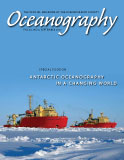First Paragraph
The Southern Ocean is especially sensitive to climate change, responding to winds that have increased over the past 30 years (Thompson and Solomon, 2002) and warming at about one degree per century in the core of the Antarctic Circumpolar Current (ACC; Gille, 2002). Drake Passage is a major control point of the ACC. It is a region of high mesoscale variability and complex topography. Eddies are thought to be essential for transferring momentum from the circumpolar winds that drive the ACC down to the seafloor where topographic form stresses regulate its transport. The cDrake experiment was designed to address fundamental dynamics not yet understood regarding wind forcing, eddy-mean momentum, and heat exchange, as well as form-drag interaction with bathymetry (Chereskin et al., 2009; http://cDrake.org).

